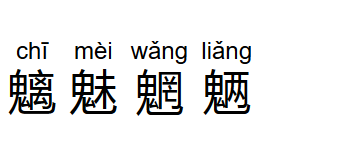【HTML5】テキストにマークを付ける
1. 基本的なテキスト要素を使用してコンテンツをマークします
まず表示効果を確認します:

対応する HTML コード:
<!DOCTYPE html>
<html>
<head>
<meta charset="UTF-8">
<title>Learn4Font</title>
</head>
<body>
<p> 元素 b —— <b> I am the example.</b></p>
<p> 元素 em —— <em> I am the example.</em></p>
<p> 元素 i —— <i> I am the example.</i></p>
<p> 元素 s —— <s> I am the example.</s></p>
<p> 元素 strong —— <strong> I am the example.</strong></p>
<p> 元素 u —— <u> I am the example.</u></p>
<p> 元素 small —— <small> I am the example.</small></p>
<p> 元素 sub —— <sub> I am the example.</sub></p>
<p> 元素 sup —— <sup> I am the example.</sup></p>
</body>
</html>対応する要素スタイル:
*一般表示关键词和产品名称*
b{font-weight: bolder;}
*一般表示加以强调*
em {font-style: italic;}
*一般表示外文词语或科技术语*
i {font-style: italic;}
*一般表示不准确或校正*
s {text-decoration: line-through;}
*一般表示重要文字*
strong {font-weight: bolder;}
*一般表示为文字添加下划线*
u {text-decoration: underline;}
*一般表示为添加小号字体内容*
small {font-size: small;}
*一般表示添加上标和下标*
sup {vertical-align: sub; font-size: smaller;}
sub {vertical-align: super; font-size:smaller;}2. 言語要素
ruby、rt および rp を使用します。要素を使用して、まず効果を確認します:

対応するコード:
<p style="max-width:90%">
<ruby>魑<rp>(</rp><rt>chī</rt><rp>)</rp></ruby>
<ruby>魅<rp>(</rp><rt>mèi</rt><rp>)</rp></ruby>
<ruby>魍<rp>(</rp><rt>wǎng</rt><rp>)</rp></ruby>
<ruby>魉<rp>(</rp><rt>liǎng</rt><rp>)</rp></ruby>
</p>3. 事前にフォーマットされたコンテンツを使用する
pre 要素は、ブラウザーがコンテンツを処理する方法を変更し、空白文字の結合を防ぎ、フォーマットを許可します。予約するソースドキュメント内にあります。


ホットAIツール

Undresser.AI Undress
リアルなヌード写真を作成する AI 搭載アプリ

AI Clothes Remover
写真から衣服を削除するオンライン AI ツール。

Undress AI Tool
脱衣画像を無料で

Clothoff.io
AI衣類リムーバー

Video Face Swap
完全無料の AI 顔交換ツールを使用して、あらゆるビデオの顔を簡単に交換できます。

人気の記事

ホットツール

メモ帳++7.3.1
使いやすく無料のコードエディター

SublimeText3 中国語版
中国語版、とても使いやすい

ゼンドスタジオ 13.0.1
強力な PHP 統合開発環境

ドリームウィーバー CS6
ビジュアル Web 開発ツール

SublimeText3 Mac版
神レベルのコード編集ソフト(SublimeText3)

ホットトピック
 7643
7643
 15
15
 1392
1392
 52
52
 91
91
 11
11
 33
33
 151
151
 HTMLは初心者のために簡単に学ぶことができますか?
Apr 07, 2025 am 12:11 AM
HTMLは初心者のために簡単に学ぶことができますか?
Apr 07, 2025 am 12:11 AM
HTMLは、簡単に学習しやすく、結果をすばやく見ることができるため、初心者に適しています。 1)HTMLの学習曲線はスムーズで簡単に開始できます。 2)基本タグをマスターして、Webページの作成を開始します。 3)柔軟性が高く、CSSおよびJavaScriptと組み合わせて使用できます。 4)豊富な学習リソースと最新のツールは、学習プロセスをサポートしています。
 HTML、CSS、およびJavaScriptの役割:コアの責任
Apr 08, 2025 pm 07:05 PM
HTML、CSS、およびJavaScriptの役割:コアの責任
Apr 08, 2025 pm 07:05 PM
HTMLはWeb構造を定義し、CSSはスタイルとレイアウトを担当し、JavaScriptは動的な相互作用を提供します。 3人はWeb開発で職務を遂行し、共同でカラフルなWebサイトを構築します。
 HTMLでの開始タグの例は何ですか?
Apr 06, 2025 am 12:04 AM
HTMLでの開始タグの例は何ですか?
Apr 06, 2025 am 12:04 AM
Anexampleapalofastartingtaginhtmlis、それはaperginsaparagraph.startingtagsaresentionentientiontheyinitiateelements、definetheirtypes、およびarecrucialforurturingwebpagesandcontingthomedomを構築します。
 HTML、CSS、およびJavaScriptの理解:初心者向けガイド
Apr 12, 2025 am 12:02 AM
HTML、CSS、およびJavaScriptの理解:初心者向けガイド
Apr 12, 2025 am 12:02 AM
webdevelopmentReliesOnhtml、css、andjavascript:1)htmlStructuresContent、2)cssStylesit、および3)Javascriptaddsinteractivity、形成、
 Giteeページ静的なWebサイトの展開に失敗しました:単一のファイル404エラーをトラブルシューティングと解決する方法
Apr 04, 2025 pm 11:54 PM
Giteeページ静的なWebサイトの展開に失敗しました:単一のファイル404エラーをトラブルシューティングと解決する方法
Apr 04, 2025 pm 11:54 PM
GiteEpages静的Webサイトの展開が失敗しました:404エラーのトラブルシューティングと解像度Giteeを使用する
 WebアノテーションにY軸位置の適応レイアウトを実装する方法は?
Apr 04, 2025 pm 11:30 PM
WebアノテーションにY軸位置の適応レイアウトを実装する方法は?
Apr 04, 2025 pm 11:30 PM
Y軸位置Webアノテーション機能の適応アルゴリズムこの記事では、単語文書と同様の注釈関数、特に注釈間の間隔を扱う方法を実装する方法を探ります...
 CSS3とJavaScriptを使用して、クリック後に周囲の写真を散乱および拡大する効果を実現する方法は?
Apr 05, 2025 am 06:15 AM
CSS3とJavaScriptを使用して、クリック後に周囲の写真を散乱および拡大する効果を実現する方法は?
Apr 05, 2025 am 06:15 AM
画像をクリックした後、散乱と周囲の画像を拡大する効果を実現するには、多くのWebデザインがインタラクティブな効果を実現する必要があります。特定の画像をクリックして周囲を作成してください...
 Routerフォルダーの下のindex.jsファイルでvue.use(vuerouter)を呼び出す必要があるのはなぜですか?
Apr 05, 2025 pm 01:03 PM
Routerフォルダーの下のindex.jsファイルでvue.use(vuerouter)を呼び出す必要があるのはなぜですか?
Apr 05, 2025 pm 01:03 PM
Vueアプリケーションを開発するときに、ルーターフォルダーの下にindex.jsファイルにvuerouterを登録する必要性があるため、ルーティング構成で問題が発生することがよくあります。特別...




